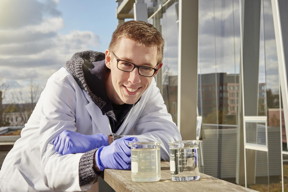Home > Press > Researchers find new, inexpensive way to clean water from oil sands production
 |
| This is Tim Leshuk, University of Waterloo. CREDIT: Light Imaging Ltd. |
Abstract:
Researchers have developed a process to remove contaminants from oil sands wastewater using only sunlight and nanoparticles that is more effective and inexpensive than conventional treatment methods.
Researchers find new, inexpensive way to clean water from oil sands production
Waterloo, Canada | Posted on November 24th, 2015Frank Gu, a professor in the Faculty of Engineering at the University of Waterloo and Canada Research Chair in Nanotechnology Engineering, is the senior researcher on the team that was the first to find that photocatalysis -- a chemical reaction that involves the absorption of light by nanoparticles -- can completely eliminate naphthenic acids in oil sands wastewater, and within hours. Naphthenic acids pose a threat to ecology and human health. Water in tailing ponds left to biodegrade naturally in the environment still contains these contaminants decades later.
"With about a billion tonnes of water stored in ponds in Alberta, removing naphthenic acids is one of the largest environmental challenges in Canada," said Tim Leshuk, a PhD candidate in chemical engineering at Waterloo. He is the lead author of this paper and a recipient of the prestigious Vanier Canada Graduate Scholarship. "Conventional treatments people have tried either haven't worked or if they have worked they've been far too impractical or expensive to solve the size of the problem. Waterloo's technology is the first step of what looks like a very practical and green treatment method."
Unlike treating polluted water with chlorine or membrane filtering, the Waterloo technology is energy-efficient and relatively inexpensive. Nanoparticles become extremely reactive when exposed to sunlight and break down the persistent pollutants in their individual atoms, completely removing them from the water. This treatment depends on only sunlight for energy, and the nanoparticles can be recovered and reused indefinitely.
Next steps for the Waterloo research include ensuring that the treated water meets all of the objectives Canadian environmental legislation and regulations required to ensure it can be safely discharged from sources larger than the samples, such as tailing ponds.
Kerry Peru and John Headley, research scientists from Environment Canada, are co-authors of the paper, which appears in the latest issue of the journal Chemosphere.
####
For more information, please click here
Contacts:
Pamela Smyth
519-888-4777
Copyright © University of Waterloo
If you have a comment, please Contact us.Issuers of news releases, not 7th Wave, Inc. or Nanotechnology Now, are solely responsible for the accuracy of the content.
| Related News Press |
News and information
![]() Researchers develop molecular qubits that communicate at telecom frequencies October 3rd, 2025
Researchers develop molecular qubits that communicate at telecom frequencies October 3rd, 2025
![]() Next-generation quantum communication October 3rd, 2025
Next-generation quantum communication October 3rd, 2025
![]() "Nanoreactor" cage uses visible light for catalytic and ultra-selective cross-cycloadditions October 3rd, 2025
"Nanoreactor" cage uses visible light for catalytic and ultra-selective cross-cycloadditions October 3rd, 2025
Discoveries
![]() Researchers develop molecular qubits that communicate at telecom frequencies October 3rd, 2025
Researchers develop molecular qubits that communicate at telecom frequencies October 3rd, 2025
![]() Next-generation quantum communication October 3rd, 2025
Next-generation quantum communication October 3rd, 2025
![]() "Nanoreactor" cage uses visible light for catalytic and ultra-selective cross-cycloadditions October 3rd, 2025
"Nanoreactor" cage uses visible light for catalytic and ultra-selective cross-cycloadditions October 3rd, 2025
Announcements
![]() Rice membrane extracts lithium from brines with greater speed, less waste October 3rd, 2025
Rice membrane extracts lithium from brines with greater speed, less waste October 3rd, 2025
![]() Researchers develop molecular qubits that communicate at telecom frequencies October 3rd, 2025
Researchers develop molecular qubits that communicate at telecom frequencies October 3rd, 2025
![]() Next-generation quantum communication October 3rd, 2025
Next-generation quantum communication October 3rd, 2025
![]() "Nanoreactor" cage uses visible light for catalytic and ultra-selective cross-cycloadditions October 3rd, 2025
"Nanoreactor" cage uses visible light for catalytic and ultra-selective cross-cycloadditions October 3rd, 2025
Interviews/Book Reviews/Essays/Reports/Podcasts/Journals/White papers/Posters
![]() Spinel-type sulfide semiconductors to operate the next-generation LEDs and solar cells For solar-cell absorbers and green-LED source October 3rd, 2025
Spinel-type sulfide semiconductors to operate the next-generation LEDs and solar cells For solar-cell absorbers and green-LED source October 3rd, 2025
![]() Rice membrane extracts lithium from brines with greater speed, less waste October 3rd, 2025
Rice membrane extracts lithium from brines with greater speed, less waste October 3rd, 2025
Environment
![]() Researchers unveil a groundbreaking clay-based solution to capture carbon dioxide and combat climate change June 6th, 2025
Researchers unveil a groundbreaking clay-based solution to capture carbon dioxide and combat climate change June 6th, 2025
![]() Onion-like nanoparticles found in aircraft exhaust May 14th, 2025
Onion-like nanoparticles found in aircraft exhaust May 14th, 2025
![]() SMART researchers pioneer first-of-its-kind nanosensor for real-time iron detection in plants February 28th, 2025
SMART researchers pioneer first-of-its-kind nanosensor for real-time iron detection in plants February 28th, 2025
Water
![]() Taking salt out of the water equation October 7th, 2022
Taking salt out of the water equation October 7th, 2022
|
|
||
|
|
||
| The latest news from around the world, FREE | ||
|
|
||
|
|
||
| Premium Products | ||
|
|
||
|
Only the news you want to read!
Learn More |
||
|
|
||
|
Full-service, expert consulting
Learn More |
||
|
|
||








